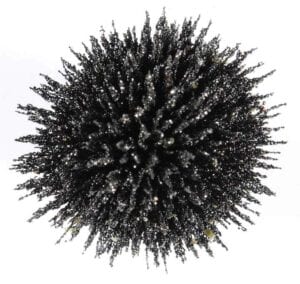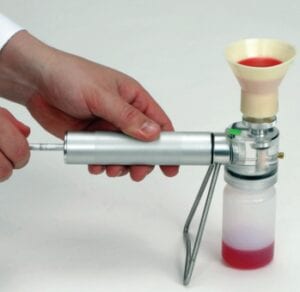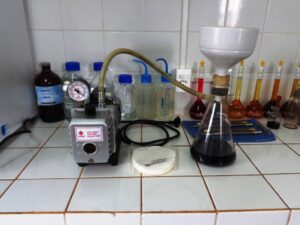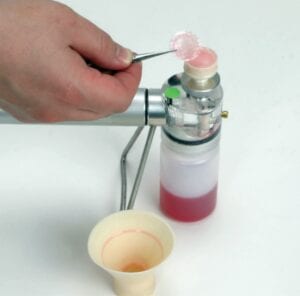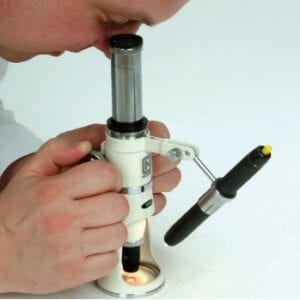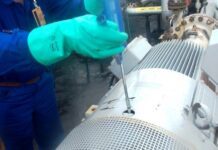
Ler em Português
Leer en español/castellano
Read in English
Marcos Thadeu Lobo
Mechanical Engineer Graduated from the State University of Campinas (Unicamp). He currently works as an Associate Consultant at QU4TTUOR CONSULTORIA.
Residues in lubricating oil
Residues in lubricating oil – On certain occasions, it is necessary to quickly determine whether mobile or industrial equipment is generating an unusual amount of metallic wear residues with a view to paralyzing or not its operation in order to carry out the maintenance activities that make themselves pertinent.
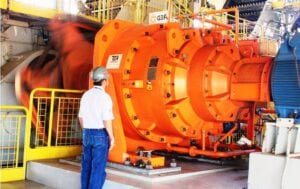
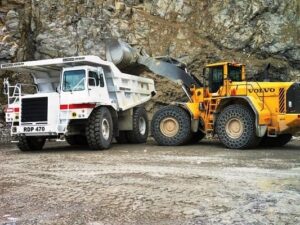 Figuras 1/2 – Em muitas ocasiões a tomada de decisão tem que ser rápida.
Figuras 1/2 – Em muitas ocasiões a tomada de decisão tem que ser rápida.
Waste analysis
One way to carry out this check is to filter the lubricating oil through a membrane and observe the solid particulate matter with a simple microscope equipped with overhead lighting. Solid particulate matter from wear tends to be bright by light reflection, especially if the particles are newly generated and have not yet undergone an oxidation process.

 Figuras 3/4 – A técnica consiste em analisar o material sólido retido na membrana.
Figuras 3/4 – A técnica consiste em analisar o material sólido retido na membrana.
Sometimes it is necessary to separate the metallic waste from wear from other impurities (sludge; silicon; varnish; sludge) in order to have a clearer view of what is happening in the machinery. The following is a description of a quick and inexpensive “on-site” method for separating wear magnetic debris (eg iron; steel). Once separated, the magnetic particles can be evaluated using a low-cost, top-illuminated field microscope.
- Mix a specified volume of lubricating oil with a suitable solvent (naphtha) in a 50/50 ratio in a flat-bottomed beaker or bottle. It is important that the solvent (naphtha) used for mixing with the lubricating oil is filtered while it is being dispensed into the beaker or flat-bottomed flask or prior to operation.

 Figuras 5/6 – É importante filtrar o solvente (nafta) antes da dispensa.
Figuras 5/6 – É importante filtrar o solvente (nafta) antes da dispensa.
- Hold a flat magnetic disk tightly against the bottom of the flat-bottomed beaker or vial and, for 3 minutes, slowly move it in a circular direction.
Figuras 7/8 – O disco magnético plano reunirá as partículas magnéticas
- Without removing the flat magnetic disk, transfer liquid and non-magnetic residues out of the flat-bottomed beaker or vial through a membrane using a manual or electrically operated vacuum apparatus. With this operation, only the magnetic particles will be retained, by the action of the magnet, in the bottom of the beaker or flat-bottomed flask.
- Remove the flat magnetic disk, add about 50 ml of filtered solvent (naphtha) and make more slow, circular movements with the magnetic disk.
- Then, using the manual or electric vacuum pump, transfer the liquid and magnetic particles to another membrane.
Figuras 9/10 – Bombas de vácuos: manual e elétrica
- Visualize the two membranes using a top-illuminated microscope. The residues retained in the first membrane will be: silica, polymers, rust, oxides, sludge, fibers, and non-ferrous wear metals (copper, babbitt, aluminum). The second membrane will show the ferrous residues generated by the wear of very critical components such as shafts, roller bearings, gears etc.
Figuras 11/12 – Análise das duas membranas com microscópio.
- If necessary, use an atlas of wear particles to interpret the metallic wear residues found in the 02 membranes.

 Figuras 13/14 – Interpretação dos resíduos metálicos de desgaste nas 02 membranas.
Figuras 13/14 – Interpretação dos resíduos metálicos de desgaste nas 02 membranas.
The technique presented is very flexible and provides “in loco” and quick information about the condition of mobile or industrial machinery. It can be used, for example, when investigating any abnormalities pointed out in the Particle Counting test, in the measurement of the Global Vibration Level, in the evaluation of the operating temperature of the machinery or even in case of suspected failure in filters lubricant. Visual confirmation of the origin of wear residues increases the maintenance staff’s confidence in making decisions and recommendations regarding the stoppage or not of mobile or industrial equipment.
 Figura 15 – Auxílio na tomada de decisões referentes ao maquinário.
Figura 15 – Auxílio na tomada de decisões referentes ao maquinário.


